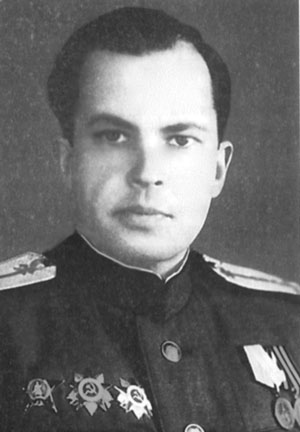 Nikolai Nazaryin
Nikolai Nazaryin
Studying the biography of the graduate of Leningrad Institute of Municipal Construction Engineers (LISI/SPbGASU), architect, urban planner Nikolai Nazaryin (1909–1993), many contemporaries believe that his military activities could become the plot of an exciting film. During the Great Patriotic War, he was a soldier, miner, officer, and military engineer. In addition to the knowledge gained at the institute, pre-war architectural and construction experience, he had natural ingenuity, ingenuity, and the ability to quickly navigate constantly changing and often unforeseen circumstances.
In 1998, the book of the architect and art historian of St Petersburg Valery Isachenko “Architects of St Petersburg of the 18th–20th centuries” was published. A separate chapter is dedicated to Nikolai Nazaryin. All information about the hero of our article is taken from the book.
Nikolai Mikhailovich was born in Belarus, in 1934 he graduated from the Leningrad Institute of Municipal Construction Engineers (now SPbGASU), in 1936 he graduated from the Faculty of Architecture of the Academy of Arts. He designed for Yaroslavl, Nizhny Novgorod, the Urals, the Far East, Leningrad. According to Nazaryin’s design, the side facades of the House of Soviets at 212 Moskovsky Ave., the largest construction project of those years, were completed. In the pre-war years, Nazaryin reconstructed one of the buildings of the hospital named after I. I. Mechnikov on 47, Piskarevsky Ave..
During the Great Patriotic War, Nikolai Mikhailovich served on the Volkhov Front, showing the best professional and personal qualities. He built bulk cells, original trenches, various defensive structures in swamps - a kind of trenches. According to his drawings, many machine gun points were built - even on tree stumps. Wartime also made him an experienced sapper. He studied the system of enemy minefields, the structure of mines and, according to the recollections of the chief of the engineering troops of the Volkhov Front, Colonel General A.F. Khrenov, from memory he could map the line of the enemy’s front line of defense in front of the entire front of the 54th Army. At the headquarters of the engineering troops, Nikolai Nazaryin headed the obstacles and engineering intelligence department. For two months he was at the forefront of defense and trained many soldiers to be sappers. Having been on intelligence service in enemy territory, he compiled a map of tank-passable areas.
After the end of the war, his long and fruitful career began at the Lenproekt Institute. The authorities, townspeople, and architects sought to preserve the historical appearance of the city, thereby keeping its spirit and flavor. Already in 1946, with the participation of Nazaryin and the architect G.I. Ivanov, a stadium with a gym “Iskra” was built on Karpovka on Barochnaya Street, and in 1947 cottages appeared in Sestroretsk. Together with the leading architects of the city of that time - V.F. Belov, N.V. Baranov, O.I. Guryev, V.M. Fromzel, L.L. Shreter, Nazaryin did a lot for the radical reconstruction of the vast outskirts of the city, especially in northern areas - Novaya Derevnya, on Lanskoye Highway and adjacent vast territories. Primorsky Avenue has turned into one of the most beautiful thoroughfares in the city. In 1946–1948 according to the project of N. M. Nazaryin, M. E. Rusakov, N. V. Baranov and V. M. Fromzel, a large residential area was created, a real “garden city”. This was a complete, well-planned and landscaped complex, which included about 100 low-rise buildings (27–61, Primorsky Ave.), forming a block-by-quarter development.
For many decades, Nazaryin combined designing facilities and urban planning in the city on the Neva with speaking in the professional press and teaching at LISI. The most famous of the architect's later works, which became the most important urban planning dominant, was house No. 1 on Torzhkovskaya Street (1970–1981). The seventeen-story slender building impressively rises on the banks of the Chernaya River; it is included in the panorama of other rivers and is visible even from Elagin Island. The house is very well connected to the green banks of the Chernaya River, its bridges and slopes, from the side of the metro station. That’s what they call it – the House of Nazaryin.
Other materials of the "Scientific Regiment" project
Our Graduate Built the Road of Life
Front Line of the Architect Aleksandr Nikolsky
Researcher who Developed Science in Besieged Leningrad
Fights of Student Klinov
Engineer of the 3rd Belorussian Front
Nineteen-Year-Old Gunner Stormed Berlin
Path of a Volunteer: from Front-Line Roads to Space Development
Ivan Solomakhin: "The Most Memorable Battle was for this Devil's Hill!"
Fiery Dnieper of the Hero of the Soviet Union Aleksandr Prygunov
Approaching to the Victory
Fedor Komal's Front: from the War Start to the Victory
Junior Political Instructor Boris Gubanov: “Shells Were Whizzing, and the Ground Took off Nearby”
Viktor Kvyatkovsky, Radio Reconnaissance Operator of the Baltic Fleet
How the Chief Architect Nikolai Baranov Kept Leningrad "Hidden" from the Enemy
Architect Nikolai Khomutetsky: Four Years at the Forefront
Semyon Shifrin Thwarted Nazi Plans to Leave Leningrad Waterless
LISI in the Post-War Years
LISI Graduate Mikhail Zherbin, Design Engineer and Composer
Abdulla Mangushev: Four Years at the Front and the Whole Life in Science
Architects Zazerskys Built and Defended the City on the Neva River
Worked His Way Up From a Lieutenant Technician to the Galaxy of Mathematicians
Konstantin Sakhnovsky: From Cadet Of the Russian Empire to Academician of the USSR